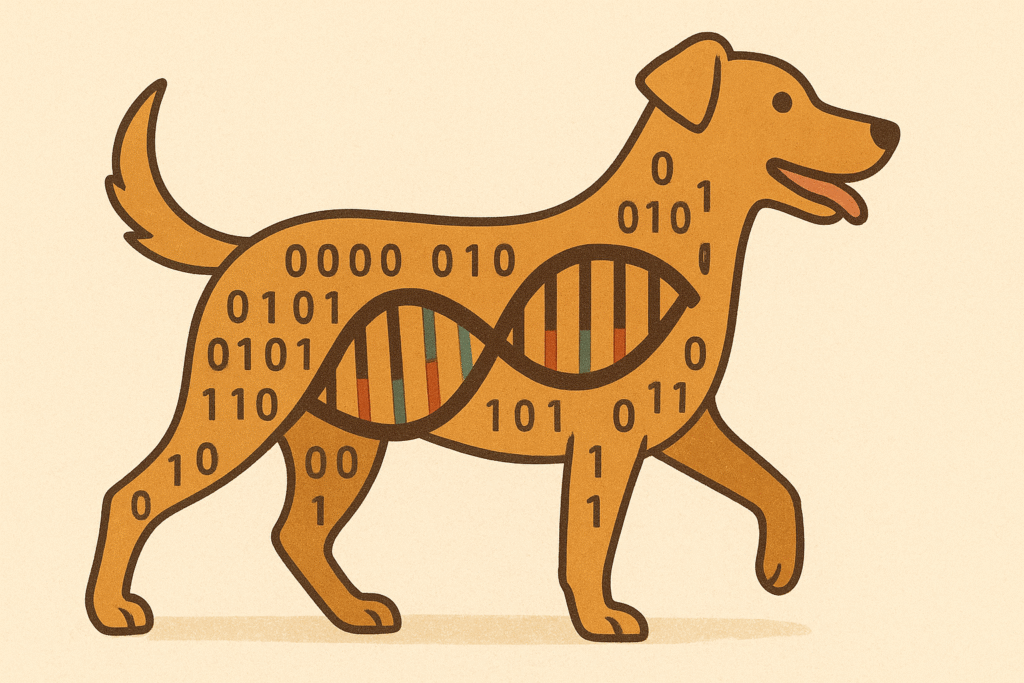Why understanding your dog’s evolutionary history is the key to urban harmony

When Ancient Genetics Meet Modern Cities
Every morning, millions of dogs navigate environments their ancestors never could have imagined. Concrete replaces grass, car horns substitute for bird calls, and cramped apartments become home base instead of sprawling territories.
For many dogs, this isn’t just an adjustment—it’s a fundamental mismatch between what their genes expect and what city life provides.
The Genetic Time Bomb in Urban Environments
Recent research in canine behavioral genetics reveals something fascinating: the behaviors we see as “city dog problems” are often perfectly normal genetic responses to environments that trigger ancient survival mechanisms.
Take the Border Collie who won’t stop “herding” joggers in the park. His genes carry thousands of years of selective breeding for controlling movement. In his genetic memory, moving objects need management. The fact that these are humans, not sheep, is irrelevant to his DNA.
Or consider the Beagle who becomes completely deaf to recall commands when a new scent appears. Her ancestors were bred to follow trails for hours, ignoring everything else. That genetic single-mindedness that made her ancestors valuable hunting partners now makes city walks frustrating for modern guardians.
The Overlooked Breed Group System
While most people think in terms of traditional breed categories, applied ethologist Kim Brophey’s research reveals a different organizational system that better explains urban behavior patterns.
Her work identifies 10 distinct genetic groups based on what dogs were actually bred to do, not just their size or coat type. This distinction matters enormously in urban settings because it predicts which city challenges will trigger genetic responses.
Gun Dogs (Retrievers, Spaniels, Pointers) were bred for cooperative work with humans. In cities, they often become anxious or overly attention-seeking because their genetic need for partnership isn’t being met in apartment isolation.
Guardian Dogs (German Shepherds, Rottweilers, Mastiffs) carry genes for independent decision-making about threats. Urban environments present constant novel stimuli, keeping their alert systems chronically activated.
Natural Dogs (primitive breeds like Huskies, Basenjis) evolved with minimal human interference. City rules about when to eat, sleep, and eliminate conflict with their genetic expectations of natural rhythms.
The Stress Cascade: When Genetics and Environment Clash
When a dog’s genetic drives can’t be expressed appropriately, stress hormones like cortisol remain elevated. This creates a cascade of behavioral changes that owners interpret as “bad behavior” or “stubbornness.”
The chronically overstimulated Terrier starts resource guarding because his “hunt and secure” genetics are triggered by urban unpredictability. The under-exercised Sight Hound becomes destructive because his “chase and capture” drives have no outlet. The socially isolated Gun Dog develops separation anxiety because cooperation and partnership are literally coded in his genes.
Environmental Enrichment Through a Genetic Lens
Understanding breed genetics transforms how we approach urban dog enrichment. Instead of generic “mental stimulation,” we can provide activities that satisfy specific genetic drives.
For Scent Hounds, this means scheduled sniffing time during walks isn’t just nice—it’s genetically necessary. Fighting their need to process scents is like asking them to ignore their respiratory drive.
For Herding Dogs, having nothing to organize or control creates genuine psychological distress. Giving them “jobs” during walks or controlled training exercises provides genetic satisfaction that generic exercise cannot.
Toy Dogs carry genes for close human partnership but often get overwhelmed by urban scale. They need security and elevated vantage points to feel safe enough to express their naturally confident genetics.
The Urban Adaptation Challenge
Some dogs adapt to city living more easily than others, and genetics play a huge role in this variability. World Dogs (mixed breeds shaped by natural selection) often show remarkable urban adaptability because their genetic diversity provides multiple coping strategies.
Conversely, dogs from highly specialized genetic lines may struggle more because their genes are optimized for very specific environments and tasks that urban life doesn’t provide.
Practical Genetic Understanding
Recognizing your dog’s primary genetic group helps explain behaviors that might otherwise seem random or problematic:
- Why your calm Guardian Dog becomes reactive only in crowded spaces (genetic alert system activation)
- Why your Bull Dog seems “stubborn” in heat (genetic cooling prioritization over commands)
- Why your Natural Dog ignores you at dawn and dusk (genetic activity rhythm activation)
- Why your Sight Hound can’t focus during walks when there’s movement (genetic visual tracking engagement)
The Path Forward
Urban dog ownership doesn’t have to mean constantly fighting genetic drives. When we understand what our dogs’ genes are “asking for,” we can find creative ways to satisfy those needs within city constraints.
The goal isn’t to suppress genetics but to redirect them. The Terrier’s hunting drive can be channeled into hide-and-seek games. The Guardian Dog’s alertness can be shaped into controlled “watch” behaviors. The Gun Dog’s cooperation need can be met through training that emphasizes partnership.
Living in Harmony with Canine Genetics
Cities will continue to grow, and more dogs will call urban environments home. The key to success isn’t better training techniques or stricter management—it’s deeper understanding of what thousands of years of selective breeding have created in our companion animals.
When we honor genetics instead of ignoring them, “problem behaviors” often resolve naturally. Dogs become calmer, more focused, and more connected with their human families. Both species get to express their nature while adapting to modern urban reality.
The secret isn’t changing your dog—it’s understanding who they genetically are and creating space for that identity within city life.
Stop struggling with generic training advice that ignores what makes your dog tick. Get the science-based roadmap to urban dog success that honors your dog’s genetic blueprint. Get “The Urban Dog Dilemma” ebook now
Understanding your dog’s genetic group can transform your urban experience together. Every behavioral challenge becomes an opportunity to meet genetic needs in creative, city-appropriate ways.



Leave a Reply